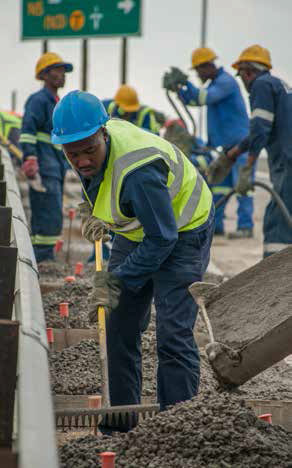
SANRAL has embarked on several major projects,
valued at billions of rands, to rehabilitate and
upgrade existing roads in the Free State, as well as
construct new roads infrastructure.
A section of the N8 from Bloemspruit to Sannaspos
was recently upgraded at an investment of R526m.
The N8 is a strategic link between Maseru and the
central regions of South Africa.
The project comprised the rehabilitation, widening
and partial realignment of more than 24km of singlecarriageway
road, as well as dualing of 4.3km of the
same section.
The road from Sannaspos to Thaba Nchu, comprising 30.5km, was also recently rehabilitated, widened and partially realigned at an investment of R490m.
632
people and
19
black-owned SMMEs were employed
on the project
The N5 is being improved between Harrismith and
Industriqwa at an investment of R290m. The contract
involves a 6km section of the N5 from the N3/N5
interchange to Industriqwa.
SANRAL Eastern Region Project Manager
Andrew Ssekayita said that a major reason for the
improvement has been the high volume of traffic
between QwaQwa and Harrismith.
A total of 226 labourers were employed on site. Of
the 29 subcontractors, 22 are SMMEs.
The N6 from Rouxville to Smithfield is being
upgraded to the tune of R480m and work is expected
to be completed by May 2020.
According to SANRAL Eastern Region Project
Manager Jason Louw, this 37km section of road
resembled an old gravel road that had simply been
tarred.
“The alignment was up and down. The narrow
road had no shoulders. Upgrading the road will give
it a freeway alignment with shoulders that will serve
as an emergency stopping lane,” he said.
Also on the N6, a 38km section of road from
Reddersburg to Rustfontein has recently been reasphalted
at a cost of R77m.
On the N8 leading to the Maseru border, SANRAL
has spent R56m on road-widening to create a
parking lane for trucks waiting to process documents at the border post, the installation of street lights, the construction of a pedestrian walkway and landscaping.
local labourers, including
24
women, were employed and
R10.1m
was paid towards local labour salaries, of which
R6.9m
went to youth and women
The project provided for business opportunities
and five local subcontractors earned R11.2m.
Two SMME subcontractors earned R3.1m for
the construction of a pedestrian walkway and the
rehabilitation of the gravel shoulder.
Rajesh Dookie, SANRAL Eastern Region Project
Manager, said the SMME subcontractors exhibited
an eagerness to increase their knowledge and
executed the work on schedule and with exceptional
quality.
Samuel Mpele of KS Mpele Construction said he
was “happy and proud” to have been involved in
the project. He said he employed 12 people during
eight months.
David Malapo, owner of DNC Construction, said
he had gained valuable knowledge and experience
working on his first SANRAL project.
AS FAR as possible, SANRAL strives to preserve
physical history, in keeping with legislation of the
South African Heritage Resources Agency.
Any structure that is more than 60 years old must
be protected in terms of heritage requirements.
It was against this backdrop that SANRAL left
the historical single-lane Hamilton Bridge over the
Wilge River intact and is building a new double-lane
bridge next to the current one on Murray Street, as
part of the upgrade of the N5 between Harrismith
and Industriqwa.
During the Anglo Boer War (1899-1902), British troops were deployed near Basuto Hill – the area known as Wilgepark. To enable the soldiers encamped in that area to reach the town, a suspension bridge was built over the Wilge River by the Royal Engineers for easy crossing of the river.
The structure was washed away in March 1904. By then the regiments were gradually moving to barracks on King’s Hill and complete repair of the bridge seemed unnecessary. The troops made a temporary footbridge of planks resting on barrels.
Today, at the same spot, a sturdier structure, called
the Hamilton Bridge, named after Sir Hamilton
Goold-Adams, governor of the Orange River Colony,
provides access to vehicular traffic crossing the
Wilge River from the town. It was opened to traffic
on 7 August 1907.
Soon, a few metres away, the new Murray Street
Bridge will carry this traffic.
